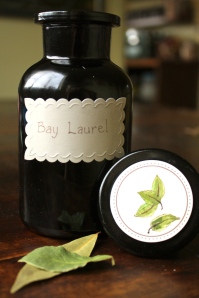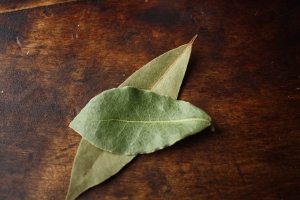 A few minutes in a hot dry pan can waken up ground spices and dried herbs to give any dish a more robust flavour. Be careful to stir the spices, so they don’t burn, and give them 2 or 3 minutes in the pan. When the fragrance has intensified to a pleasant level, add the rest of the ingredients. In this case, can of organic diced tomatoes with no salt added to make spaghetti and meatballs.
A few minutes in a hot dry pan can waken up ground spices and dried herbs to give any dish a more robust flavour. Be careful to stir the spices, so they don’t burn, and give them 2 or 3 minutes in the pan. When the fragrance has intensified to a pleasant level, add the rest of the ingredients. In this case, can of organic diced tomatoes with no salt added to make spaghetti and meatballs.
Category Archives: Herbsday
Kitchen Hack: Toast your dried herbs and spices
Clam Linguine with Greenery
When days turn snowy we seem to reach for the foods that have comforted us in winters past. I’ve been making clam linguine from my grandmother’s recipe for the last couple of decades and it’s a favourite of my son and my best friend, two of the most important people in my life. While I want to feed and comfort them, I also feel the need to nourish them and keep them healthy. Over the years, I’ve tweaked frequently cooked dishes to be a bit healthier while still maintaining the textures and flavours that made them staples at our table.
I’m always trying to work more green vegetables into meals and one day when I was picking up supplies for Clam Linguine, I thought about how it’s the only time I like to use lots of parsley in a dish. Realizing that it was because the parsley absorbed all the other flavours, I wondered if kale wouldn’t just do the same thing. By quickly blanching the kale in the pasta water before adding it to the pan and reducing the amount of pasta, it added lots of vitamins and nutrients without taking anything away from a beloved dish.
When I tested the altered pasta dish on my son, he approved and ate about half of a bunch of kale! When I made a lunch date with my best gal where she wanted to make Clam Linguine together at her place, I figured it was a great chance to test out the changes on a “mature” palate. With a splash of Wayne Gretzky wine, I dished up the greener version of the recipe we’d been cooking together since high school and got our daily greens with a side of witty banter.
Recipe for Clam Linguine with Greenery
makes 2 very generous servings
Ingredients:
150 ml (5 oz) canned whole baby clams
2 cloves garlic, sliced thinly
5 Tablespoons fresh parsley, minced
1 bunch fresh kale
120ml (4 oz) dry white wine or broth
1 Tablespoon butter
5 Tablespoons olive oil
Salt and pepper to taste
Method:
1. Bring salted water to a boil. Wash and tear up kale into bite size pieces, discarding the spines.
2. Melt butter and olive oil in a large sauté pan on medium. Add sliced garlic and sauté until golden.
3. Blanch kale in boiling salted water for 1 minute. Add parsley, wine or broth, clam nectar (from the can) to the garlic pan and transfer kale with a slotted spoon from pot to pan
. Simmer for 5 minutes.
4. Add pasta to same pot of boiling water. Add clams to sauté pan and salt and pepper to taste then simmer for another 5 minutes.
5. Add pasta to saute pan with sauce and allow to sit with burner off until most of the sauce is absorbed.
6. Serve with freshly grated parmesan cheese.
Do you have a treasured recipe that you’ve ‘greened’?
Related articles
- Tuesday Pasta Night: Take One (relentlesswandering.wordpress.com)
- Linguine and Clam Sauce (herbsinthewindow.wordpress.com)
- Sausage and Kale Pasta (homeintimefordinner.wordpress.com)
- Marinara Linguine Recipe by Antonio Ruggerino (thecalabrian.net)
- bon appétit : kale, sausage, and tomato pasta (jacquelinecote.com)
- Go Ahead, Make it a Pasta Night (affinityacupuncture.wordpress.com)
- Cooking Clams (ideasinfood.com)
- Shrimp Linguine with Fresh Gluten Free Pasta (thepreparedtable73.wordpress.com)
- Week 9: Linguine with Sardines, Anchovies and Parsley (newrecipenight.wordpress.com)
Bay Leaf Bonanza
My favourite part of our kitchen, since our renovation, is the shelf that cradles my collection of spices and herbs. I can travel the world just by inhaling the heady aromas enclosed in the purple apothecary jars that preserve the flavourful treasures within. I’d like to share some of these seasonings and why they make me so giddy!
The scent of Bay Leaf always takes me back to the California coast where groves of California Bay Laurel trees fill the air with a heady scent as the trees sway in the constant ocean breeze. My other strong scent associated memories of California are the night-blooming jasmine in Napa and the ever-present scent of Ranch Dressing in the capital city of garlic, Gilroy. While the leaves of the California Bay Laurel can be used for seasoning dishes, the more subtly flavoured Bay Laurel that is native to the Mediterranean is more commonly used in cooking and more widely available. There are also other varieties of Laurel trees outside of Europe that are used in local cuisines, including: Indian Bay Leaf, Indonesian Bay Leaf, West Indian Bay Leaf and Mexican Bay Leaf. Each has a different flavour profile, but they all have a similar appearance.
While dried Bay Leaf can be purchased at any grocery store, it’s always better to dry the fresh leaves yourself for maximum flavour. While I have never been lucky enough to have my own Bay Laurel, I have been the recipient of branches from generous friends and neighbours who have. My most recent bough was overflow from a bushel given to my mother. The fresh leaves are quite mild and need to be dried for several weeks to reach their full flavour capacity. I like to use the newly dried leaves as I find the flavour is more buttery and rich. In the photo below, the leaf on top is one from the branch above and the bottom leaf was purchased.
I use Bay Leaf in almost every soup and sauce that I make (including Cranberry Sauce), as it works well with most other spices and herbs adding a slightly floral complexity. I always use whole leaves and fish them out near the end as they are inedible unless ground to a fine powder. You can also place the smaller pieces in a tea ball or muslin bag, which can also be improvised with cheese cloth. As with many herbs and spices, bay leaves have long been used for their medicinal properties, but the leaves of the laurel tree are most often associated with the laurel wreaths worn by Olympians in Ancient Greece and victors of war in Ancient Rome. Bay Leaf is always a winner in my books and I will continue to rest on my laurels when I’m looking to create a more complex flavour.
 What dishes just wouldn’t be the same without a hint of bay leaf?
What dishes just wouldn’t be the same without a hint of bay leaf?
Related articles
- Bay Leaf Know Your Herbs and Spices (foodiefriendsfridaydailydish.com)
- Bay Leaf (sagemooncottage.wordpress.com)
- All I need…. is a bay leaf (wildflowerramblings.wordpress.com)
- Top 10 Favorite Herbs and Spices (marksdailyapple.com)








